The medicinal mushroom Thelephora vialis. The groundwart, Thelephora vialis Schwein.
Synonyms
Phylacteria vialis (Schwein.) Pat.
Essai Tax. Hyménomyc.: 119 (1900)
Thelephora tephroleuca Berk. & M.A. Curtis
Grevillea 1(no. 10): 149 (1873)
Common names
Groundwart
Common fiber vase
Gamba-jun (Yunnan, China)
Description
Fruiting body: 2-10 cm tall, 2-15 cm wide, surface color varying from yellow, light buff to cinnamon brown, grey to beige; infundibuliform to vase-like or cup-like, imbricately lobed at center; hymenium smooth or pipallose.
Stem: 5-50 mm thick, eccentric to central, whitish to gray.
Flesh: thick, like leather (coriaceous).
Spores: olive-buff color under microscope, angular and lobed/tubercular, spiny, 5-8 x 4.5-6 µm.
Spore print: light to dark brown.
Habitat: grows on the ground in forests, especially near oak.
Distribution: Found in North America (McKnight and McKnight, 1987), New Zealand, Australia (Cunningham, 1963) and Japan.
Odor: fetid.
Edibility: unclear. One recent paper claims it is “one of the most favored edible mushrooms, due to its flavor.” (Onose et al., 2008). Other sources, such as Roger’s Mushrooms, list it as inedible. From Daniel Winkler’s foray report in Tibet, one learns that the related species T. ganbajun, which he says “was formerly known as Thelephora vialis Schwein.” is a choice edible. Furthermore, Dai et al. (2004) list T. vialis Schwein., but do not list T. gambajun. For now, I will consider T. vialis and T. gambajun as distinct species until I find out more information.
Use in traditional Chinese medicine
This species is used in the making the ‘tendon-easing pill’, which apparently “cures lumbago and pain in legs, numbed hands and feet, uneasy tendons and veins, and tetany in limbs.” (Ying et al., 1987, p.77).

My name is Austin Collins.
I've dedicated my life to Mushrooms.
I believe Mushrooms are the best kept secret when it comes to health and well being.
For that reason, I would like to share a company with you that in my opinion makes the best mushroom products on the market.
The company is called Noomadic Herbals, my favorite supplement they make is called "Mushroom Total".
I take their products every day and they have helped me think better and have more energy. Give them a try.
-Austin
Medicinal properties
A polyphenol, named thelephorin A (shown below), was isolated from the fruiting bodies of the mushroom Thelephora vialis (Tsukamoto et al. 2002). Thelephorin A was shown to have potent antioxidative activity, 10 times as active as ascorbic acid in a DPPH˙ free radical scavenging assay.
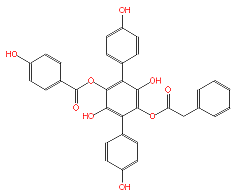
Additionally, another new potent antioxidant, vialinin A (1, 5′,6′-bis(phenylacetoxy)-1,1′:4′,1″-terphenyl-2′,3′,4,4″-tetraol), together with a known compound, ganbajunin B, and a mixture of ganbajunins D and E, have been isolated from T. vialis. Vialinin A had strong 2,2-diphenyl-1-picrylhydrazyl (DPPH) free radical-scavenging activity with an EC50 value of 14.0 µM, nearly equal to that of well known radical scavenger, butylated hydroxytoluene (BHT; EC50 = 10.0 µM) (Xie et al., 2005).
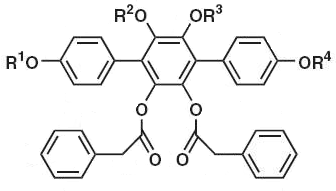
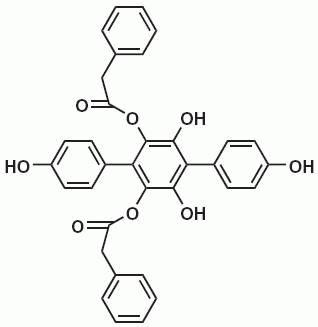
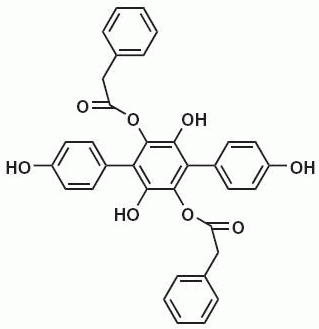
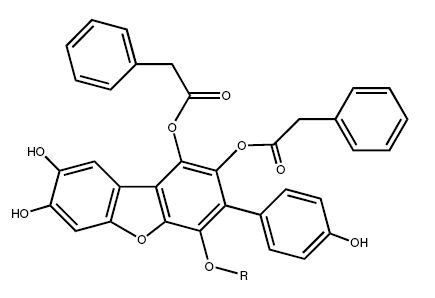
Structures of ganbajunin B (R= ), and vialinin B (3-(4-hydroxyphenyl) dibenzo-furan- 1,2,4,7,8-pentaol- 1,2-O-diphenylacetate; R=H). The latter has potent TNF-α inhibitory activity and has potential as an anti-allergic compound.
), and vialinin B (3-(4-hydroxyphenyl) dibenzo-furan- 1,2,4,7,8-pentaol- 1,2-O-diphenylacetate; R=H). The latter has potent TNF-α inhibitory activity and has potential as an anti-allergic compound.
A novel dibenzofuran compound designated vialinin B (shown above) was isolated from the fruiting bodies of T. vialis (Xie et al., 2006). This compound was shown to strongly inhibit tumor necrosis factor alpha (TNF-α) release from rat basophilic leukemia (RBL-2H3) cells in a dose-dependent manner. Vialinin B has an IC50 value of 0.02 nM, approximately 20,000 times more effective than ganbajunin B (IC50 = 5000 nM) and cycloleucomelone (IC50 = 3500 nM), and roughly comparable to the clinical immunosuppressant FK-50612 (aka tacrolimus, IC50 = 0.25 nM).
In addition to the antioxidant activity noted above, vialinin A demonstrated anti-allergic activities such as the inhibition of β-hexosaminidase, TNF-α, interleukin 4 and monocyte chemotactic protein 1 release from RBL-2H3 cells. In contrast, both atromentin and a mixture of ganbajunins D and E did not have these effects. The IC50 for inhibition of TNF-α production from RBL-2H3 cells was 0.09±0.01 nM, indicating a potent activity stronger than tacrolimus (IC50=0.25 nm±0.03) (Onose et al., 2008).
References
Cunningham GH.
Bull NZ Dept Sci Ind Res. 1963 145:1-359.
Dai Y-C, Wei Y-L, Zhang X-Q.
An annotated checklist of non-poroid Aphyllophorales in China.
Ann Bot Fennici. 2004 41:233-247.
PDF online
McKnight KH, McKnight VB. 1987.
A Field Guide to Mushrooms.
North America: Houghton Mifflin: Boston. pp 76-78.
Onose J, Xie C, Ye YQ, Sugaya K, Takahashi S, Koshino H, Yasunaga K, Abe N, Yoshikawa K.
Vialinin A, a novel potent inhibitor of TNF-α production from RBL-2H3 cells.
Biol Pharm Bull. 2008 31(5):831-3.
PDF available online
Tongxin Z, Wei R.
Taxonomic study on two edible species of Thelephora in Yunnan.
Acta Botanica Yunnanica.1986 8(3):295-7.
Tsukamoto S, Macabalang AD, Abe T, Hirota H, Ohta T.
Thelephorin A: a new radical scavenger from the mushroom Thelephora vialis.
Tetrahedron. 2002 58(6):1103-5.
Xie C, Koshino H, Esumi Y, Takahashi S, Yoshikawa K, Abe N.
Vialinin A, a novel 2,2-diphenyl-1-picrylhydrazyl (DPPH) radical scavenger from an edible mushroom in China.
Biosci Biotechnol Biochem. 2005 69(12):2326-32.
Xie C, Koshino H, Esumi Y, Onose J, Yoshikawa K, Abe N.
Vialinin B, a novel potent inhibitor of TNF-α production, isolated from an edible mushroom, Thelephora vialis.
Bioorg Med Chem Lett. 2006 16(20):5424-6.
Ying J, Mao X, Ma Q, Zong Y, Wen H.
Icones of Medicinal Fungi from China. Xu, Y. (Trans.)
Science Press: Beijing. 1987.


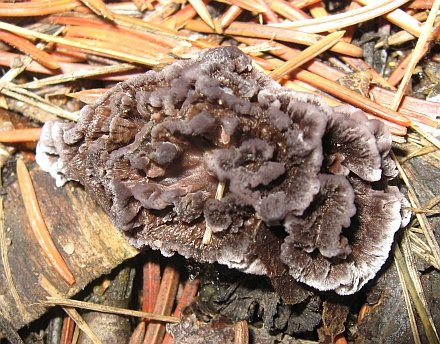

Wow! So glad I found you. This is some awesome stuff you are sharing.